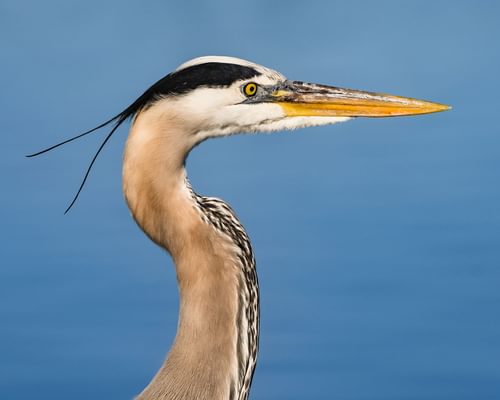The great blue heron is a species of wading bird widely known for its blue-gray plumage streaked with white and black. The species is the largest heron in North America, with adults standing at a little over 5ft tall.
Blue herons reside in freshwater and saltwater wetland and lake habitats throughout North and Central America. It is not uncommon to see these birds wading through cattails and rushes as they hunt near shorelines, but have you ever seen their babies?
Baby blue heron sightings are surprisingly rare, providing the general public little opportunity to observe their behavior. Throughout this article, we will delve into some of the most commonly asked questions about baby blue herons. Read on to discover more!
What does a baby blue heron look like?
Upon hatching, baby blue herons have a pale gray down covering their head, back, and sides. Down is particularly full on the crown, measuring up to an inch long. At this stage, the throat has no down. In addition, the wings, bill, and legs are mostly bare and pinkish-gray in color. The chick’s eyes are open at hatching, appearing bluish.

Great Blue Heron chicks in the nest
Why do you never see baby blue herons?
It is rare to see baby blue herons because they generally stay on the nest for the first 60-90 days after hatching. Adult great blue herons also conceal their nests very well. Preferred sites are in trees, with nests nearly 100 feet off the ground.
When trees are unavailable, herons will build nests on the ground, but these sites are usually on an island not easily accessed by predators. If you ever do stumble across a blue heron nest with chicks present, it is best to leave the area calmly but quickly. Human disturbance could be detrimental to the nestlings.

A blue heron with two chicks in the nest
How big are baby blue herons?
Blue heron nestlings have typically gained 86% of their adult weight 45 days after hatching. Adults weigh between 4.5 and 5.5 pounds.
How much do baby blue herons weigh?
On average, male blue heron chicks weigh about 54 grams at hatching, and females weigh around 53 grams.
What do juvenile blue herons look like?
Juvenile blue herons are brownish overall, with more loose, disheveled feathers. Their crowns are dark gray; the outer edges of their wings have light rust-brown coloration. Young great blue herons generally wear their juvenile plumage in June through October.

Blue Heron juveniles in the nest with one of their parents
What is a baby blue heron called?
Baby blue herons are usually called chicks. While in the nest, they may also be referred to as nestlings and, once they fledge, fledglings.
What do baby blue herons eat?
Baby blue herons eat regurgitated food given to them by both parents. Generally, the adults will perch on the edge of the nest and feed their chicks by dropping food into their mouths. Occasionally, the chicks will pick up regurgitated food dropped into the nest.
The chicks start taking whole food directly from their parents about thirty days after hatching. Small fish are the primary food items adult blue herons bring to their chicks. They also eat crabs, crayfish, tadpoles, frogs, turtles, snakes, lizards, spiders, grasshoppers, and other insects.

A great blue heron feeding chicks
How do blue herons feed their chicks?
Great blue herons begin feeding their chicks by dropping regurgitated food into their mouths. After about thirty days, the parents bring small but whole fish, amphibians, reptiles, crustaceans, and insects to the nest.
Do both parents feed baby blue herons?
Both parents take part in feeding their chicks. For the first thirty days after hatching, adult great blue herons feed nestlings by regurgitating food into the chicks’ mouths. After this period, the adults begin bringing whole food to the nest.
Feeding begins to taper off after the chicks fledge, about 60 days after hatching. However, chicks usually return to the nest to be fed by their parents for three weeks after fledging.

Blue Heron nestlings
What do blue heron eggs look like?
Great blue heron eggs are pale blue. However, this color tends to fade closer to hatching. The eggs are oval-shaped, with some more elongated than others. Size ranges from 2.4-3.0 inches in length and 1.8-2.0 inches in width.
How long do blue heron eggs take to hatch?
The incubation period of great blue heron eggs generally falls between 27 and 29 days. The countdown begins after the laying of the first egg. Both parents participate in incubation, but males may sit on the nest for longer periods than female Great Blue Herons.

Great Blue Heron (Ardea herodias) sat on the nest
How many babies does a blue heron have?
The clutch size for great blue herons is 2 to 6 eggs. A pair will usually have one or two broods per breeding season.
When do blue herons lay eggs?
Great blue herons typically lay their first eggs of the breeding season between March and April. Laying occurs earlier in warmer climates. Occasionally, a pair will raise a second brood. More than one brood per season is more likely if the first clutch was unsuccessful.
How long do baby blue herons stay with their parents?
Baby great blue herons stay with their parents for about eight weeks. During this period, the young primarily remain in and around the nest, relying on their parents to bring food. After fledging, the chicks stay near the nest for another 2-3 weeks, continuing to be fed by the adults.

